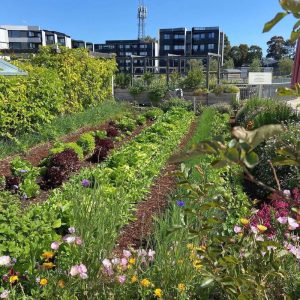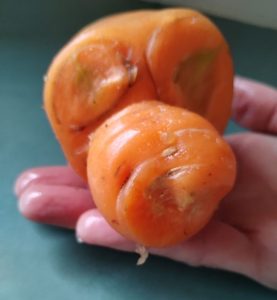Thanks to the people who have contributed to this week’s newsletter: Bev Middleton, Celesta Van der Paal, Julie French, Olaf Falafel, Pam Jenkins, Rob Rees, Sarah Young, Vanessa Veldman and Vicki Jordan.
How to use and cook celeriac (by Julie French)
[Julie, from the Montmorency Community Group, has volunteered to write a series of articles ab out how to use and cook various unusual vegetables. First up is celeriac. Thanks Julie!]
 One of the pleasures of the change of seasons is to see old veggie friends appear in the market stalls at the Eltham Farmers’ Market. A favourite of mine is the rough and knobbly celeriac root, which I queue up for at Silvertine Farm no matter the weather. Not the most attractive of vegetables, it doesn’t call out “eat me”, but it is tasty and worth adding to your winter repertoire. Celeriac is a variety of celery cultivated widely around the Mediterranean and has a long history – it was mentioned in the Iliad and Odyssey.
One of the pleasures of the change of seasons is to see old veggie friends appear in the market stalls at the Eltham Farmers’ Market. A favourite of mine is the rough and knobbly celeriac root, which I queue up for at Silvertine Farm no matter the weather. Not the most attractive of vegetables, it doesn’t call out “eat me”, but it is tasty and worth adding to your winter repertoire. Celeriac is a variety of celery cultivated widely around the Mediterranean and has a long history – it was mentioned in the Iliad and Odyssey.
Celeriac can be prepared and eaten in many ways and is a good alternative to potato, especially if you’re trying to cut back on carbohydrates. As well as being low in carbs and fat, it is high in fibre and a good source of vitamins B6, C and K. It also contains important minerals, such as phosphorus, potassium and manganese. Finally, it has been used in traditional Chinese medicine for its supposed anti-inflammatory qualities.
All parts of the celeriac, can be used – including the skin if you scrub it really thoroughly. The bulb itself can be roasted, mashed, gratineed, used in fritters and tarts or used raw (as in the classic French rémoulade). The stems and leaves can be used in the same way you’d use celery.
A tip before you start: once peeled and cut, celeriac will discolour. This makes no difference to the flavour but, if you want it to look less grey, rub the peeled bulb with some lemon, or drop sliced/cut pieces into some acidulated water.
Things to do with celeriac:
- Substitute celeriac for potatoes to make chunky chips.
- Mash it on its own or add some potato to make a creamier mash (celeriac has a higher water content than potato).
- Peel, shave thin slices horizontally, pat dry and deep fry to make celeriac crisps.
- Make a gratin with thinly sliced celeriac – boil slices until just tender then arrange in a buttered dish, sprinkle each layer with grated parmesan, salt and pepper, pour over a little cream and top with parmesan, some dobs of butter and breadcrumbs. Bake at 200degC.
- Make a winter veggie bake with celeriac, pumpkin, Brussels sprouts, onion, tinned chopped tomatoes and whatever else you have to hand. Cook at 190degC till the veggies are tender, then top with some sliced haloumi drizzle with olive oil and bake for a further 15 minutes.
- Grate it and use it in fritters (see recipe below).
- Finely chop the stems to garnish soups.
- Add stalks, stems and skin to your vegetable stock pot.
- Make a salad such as a classic French céleri-rémoulade (see below).
Celeriac and potato cakes
1 large celeriac, peeled and grated
2 medium potatoes, peeled and grated
2 eggs
grated rind from a large lemon
2 tablespoons chopped parsley
salt and pepper
Put the celeriac into a clean tea towel and squeeze to remove as much water as you can. Place all the ingredients into a bowl and mix together well.
Heat a frying pan over medium heat, add a little oil and a knob of butter. When the butter is sizzling, add tablespoonfuls of the mixture (be careful not to crowd the pan) and cook for 2-3 minutes on each side, or until golden.
Serve with slices of smoked salmon or smoked trout and sour cream.
Céleri-rémoulade (from Jane Grigson’s Vegetable Book)
Cut one good sized celeriac into julienne (matchstick) lengths and mix with 200-250 ml good quality Dijon mustard flavoured mayonnaise. Decorate with chopped parsley.
[If Julie’s article inspires you to want to eat celeriac, you might be interested in Robin Gale-Baker’s article on our website about how to grow celeriac.]
Preserving chillies (by Celesta Van der Paal)
[This is the third article that Celesta has written for the newsletter in recent weeks. Thanks, Celesta! I have set up a page on our website to where her various surveys of supermarket products will be collated.]
 The easiest way to preserve small, thin chillies is simply to dry the fruit. After a bit of experimentation, this is how I (Celesta) do this.
The easiest way to preserve small, thin chillies is simply to dry the fruit. After a bit of experimentation, this is how I (Celesta) do this.
Use a large embroidery needle with an eye that is large enough to thread cooking twine through the eye.
Sterilise the needle. Thread the twine/string through to measure about 50cms (or as long as you would like your string of chillies to be), then cut the string. Make a knot at the end of the string and start threading on the chillies. Insert the needle at the junction of the pedicel (aka stalk) and the calyx (the green part that is attached to the chilli). For the first chilli, tie a knot around the calyx to stop the chilli falling off. Then continue to thread on more chillies, one at a time, keeping adequate space between each chilli to allow for air flow around the entire fruit. No extra knots are needed as the chillies stayed in place by remaining gripped to the string.
Hang in the laundry or equivalent.
Leave for about two months and then store in sterilised dry jars.
A year later, these stored chillies are still dry and mould free and can be used in cooking whole or flaked using a small blender.
I have also had success drying garlic and oregano in the same way. I tie twine around large bunches of oregano and, for garlic, I tie twine around the green stem then tie this string to the line.
The lists below show where our dried products of chilli, garlic and oregano are sourced in our two major supermarket chains:
- Chilli flakes: 2 brands from India; 3 packed in Australia (PIA).
- Crushed chilli: 2 brands from China; 1 PIA; 1 produce of Australia.
- Garlic powder: 1 brand from China; 1 from India; 1 from USA; 1 PIA.
- Minced garlic: 4 brands from China; 1 produce of Australia.
- Dried oregano: 1 brand from India;1 from Greece, 1 PIA.
- Semi-dried oregano: 1 brand produce of Australia.
It is interesting to see how many products are marked as packed in Australia, which effectively hides their source.
Now that I’m paying attention, I also think that it is quite revealing to see how much imported food is on our supermarket shelves.
Do you know?
Celesta has only used the method above for small, thin chillies but she would also like to dry larger chillies. Are food dehydrators the way to go? What methods do you use. Email us with your thoughts.
 More on using spent coffee grounds
More on using spent coffee grounds
Following last week’s article about Reground being a bit short of gardeners to deliver their free, spent ground coffee to, Vicki Jordan has written in: “I had coffee grounds delivered around 3 months ago and the worms love it! I keep the grounds covered and add them to my compost periodically. I’m extremely happy with the result.“.
In 2018, Gardening Australia did a 5 minute segment about Reground’s service, including an interview with newsletter reader Stuart Rodda.
The Wangim Cup Project
 The Wangim Cup Project is a Darebin initiative where you can borrow a re-usable coffee cup at one of the participating cafes and return it at a later date to any of the cafes. In other words: borrow then use then return. The objective is to reduce the use of single-use cups. 26 Darebin cafes are participating.
The Wangim Cup Project is a Darebin initiative where you can borrow a re-usable coffee cup at one of the participating cafes and return it at a later date to any of the cafes. In other words: borrow then use then return. The objective is to reduce the use of single-use cups. 26 Darebin cafes are participating.
In some ways the initiative is analogous to boomerang bags and, indeed, ‘wangim’ means ‘boomerang’ in Woiwurrung, the language of the Wurrundjeri people of the Kulin Nations. And, like boomerang bags, there is some ‘leakage’ in the system, whereby the number of cups available reduces over time unless replenished. In this context, an organisation called Awareaway is helping the Wangim Cup Project to rescue unwanted re-usable cups. If you have any spare re-usable cups, you can drop them off at any of Alphington Farmers’ Market (at the Northcote Bakery Store), The Northcote Bakeshop or the Moon Rabbit Cafe in Preston.
Burwood Brickworks Rooftop Farm
 In last week’s newsletter, we discussed a number of upcoming events at Burwood Brickworks Rooftop Farm. The farm is an interesting place so I thought that I would say a few words about it. The farm is on the roof of a shopping centre and covers around ½ an acre. It is open to the public whenever the shopping centre is open and is well worth a visit. At 70 Middleborough Road, Burwood East. Here is a short drone video of the farm.
In last week’s newsletter, we discussed a number of upcoming events at Burwood Brickworks Rooftop Farm. The farm is an interesting place so I thought that I would say a few words about it. The farm is on the roof of a shopping centre and covers around ½ an acre. It is open to the public whenever the shopping centre is open and is well worth a visit. At 70 Middleborough Road, Burwood East. Here is a short drone video of the farm.
Cultivating Community recently took over the management of the farm. Here is some of the blurb from their marketing material: “Together in collaboration, Cultivating Community and Burwood Brickworks will develop the rooftop farm into a thriving landscape that improves social connections. Food will be grown that can be provided to communities and projects throughout Melbourne who may be facing barriers to culturally appropriate fresh food. The location will also be activated as a pathway to employment for a variety of organisations including in particular CALD groups and those who are deaf or hard of hearing. Over time, some produce will be commercially sold to secure ongoing funding directly to consumers or local cafes and restaurants or school canteens. An activities and workshop calendar will offer opportunities for people of all ages to engage in food systems knowledge as the rooftop farm becomes a learning and education space. You will also start to see a stronger cultural diversity of products grown to represent local communities.”
The shopping centre itself is noticeably different than your average shopping centre, with lots of plants, natural light, recycled timber, solar panels and other eco-friendly features. It is worth a visit in its own right. It is also the only place in Melbourne that I (Guy) know of where you can sometimes buy Ben & Jerry’s Cherry Garcia ice cream!
Thanks to Rob Rees, CEO of Cultivating Community, for providing some of the information above.
Are you a serious baker?
The John Reid Fellowship is providing $8K in funding “for young or emerging leaders in the local grains movement, to undertake a project that connects them with people in the local grain economy to build solidarity networks across all aspects of the food system.” Closing date: 2nd July. Read more and potentially apply.
Thanks for the heads up, Sarah Young.
Every newsletter needs a good picture
 ‘Carrot dog’, submitted by Pam Jenkins.
‘Carrot dog’, submitted by Pam Jenkins.
‘Crowd harvest’ – Winter citrus
Lemon trees and other citrus are often heavily laden in the middle of winter. Gardeners with excess are invited to give them throughout the Winter to one of the not-for profit organisations listed in the next paragraph who will, in turn, provide them to those facing food insecurity. Read this Facebook post for more information.
DIVRS in Preston, Elisha Care in Croydon, Liberty Church Epping or STREAT in Collingwood.
Your weekly facts about earthworms
Bev Middleton, from Soil Week Australia: Earthworms are expert tunnellers and can burrow up to two meters below the ground. Their tunnels help with soil aeration and nutrient distribution by creating channels for water to flow through.
Charles Darwin via Guy Palmer: Earthworms are everywhere. They are mainly nocturnal, blind (but can sense light) and deaf.
Soil Week Australia is currently running a competition for school students on the topic of ‘wonderful worms’. Read more and potentially enter.
Which link was clicked most times in the last newsletter?
The most popular link in the last newsletter was Jian Liu’s article on how to use spent coffee grounds.
 Joke (or pun) of the week
Joke (or pun) of the week
When vegetarians give up something they have to go cold tofu. (Submitted by Olaf Falafel)
Regular activities over the coming week
Farmers’ and other food markets
- Friday: Community Grocer, Carlton.
- Saturday: Abbotsford, Carlton and Coburg.
- Sunday: Alphington, Eltham and Whitehorse.
- Tuesday: Community Grocer, Fitzroy.
- next Wednesday: Really Really Free Market (Coburg).
North East Region Permaculture (NERP) will be at Eltham Farmers’ Market from 9-11am, where their topic of the month will be soil. Drop by to ask any questions about compost, nutrient tea, rock dust, leaf mould, green manures, vermiculture, hugelkultur or mulch.
Food swaps
- Saturday: Brunswick East, Hurstbridge and Mooroolbark.
- Sunday: zip.
Community gardens
- Thursday: Diamond Valley Library (Greensborough), Edible Hub (Hurstbridge), SEEDs (Brunswick) and Whittlesea.
- Friday: Reynard Street (Coburg) and West Brunswick.
- Saturday: Links (Lalor), Macleod, Northcote Community, Tables (Heathmont) and Thrive (Diamond Creek).
- Sunday: Bellfield, Fawkner Food Bowls, Pentridge (Coburg), Regent (Reservoir) and West Brunswick.
- Monday: Panton Hill, SEEDs (Brunswick) and Whittlesea.
- Tuesday: Diamond Valley Library (Greensborough), Doncaster Hill and Watsonia Library.
- Next Wednesday: Bellfield, Eltham Neighbourhood House, Macleod, Newton Street (Reservoir), Span (Thornbury) and Sylvester Hive (Preston) .
Upcoming face-to-face events – not cooking
Wicking bed workshop; Thursday, 6th July, 10am-2pm; $45 ($11 per hour); Panton Hill.
Melissa Houselander will show you how to make a wicking bed from scratch by building a wicking bed for the Panton Hill Community Garden. You will learn: about the concept of a wicking bed and how it works; what materials to use; how to layer your wicking bed; tips and tricks for growing plants in your wicking bed; and ongoing maintenance and care for your wicking bed. A light lunch will be included.
Introduction to horticulture (8 sessions); Monday for 8 weeks, starting 10th July, 10am-2.30pm; $70 ($2 per hour); Eltham.
This course is ideal for people considering a career in horticulture. No prior experience is necessary. Working as a team with fellow participants, you will gain a broad overview and practical, hands-on experience about such topics as: introduction to plant recognition; propagation; planting; soil properties; environmentally sustainable work practices; and career pathways / further study in the horticulture industry. You will spend some time outdoors (getting your hands dirty!) along with some time in the classroom. Tutor: Justin Calverley. Organised by Living & Learning Nillumbik.
The fungus amongst us; Saturday, 29th July, 10am-12.30pm; $60 ($24 per hour); Alphington.
Explore the Darebin park lands through a fungal lens. Participants will be guided to see and get close to the local world of fungi. The park adventure will be led by local ecologist Dr Sapphire McMullan-Fisher. Founder of Sporadical City Mushrooms, Julia Laidlaw, will then share the world of zero waste mushroom farming at her farm on the edge of the park land.
How to become self reliant workshop; Saturday, 29th July, 10am-1pm; $165 ($55 per hour); Mount Evelyn.
Learn from the owners of Big Little Farm who are a living example of self reliance and community building. The class will include: growing your own food (vegetables, fruit, berries and the infrastructure and seasonal requirements); developing closed loop systems; strategies to capture, store and move water without paying a cent to water companies; developing and maintaining healthy soil; how to compost for maximum harvest returns; animal integration and how to raise animals for meat; building and maintenance, reclamation methods; home economics (preserving food, home-made toiletries and basic medicines); becoming your own maintenance and repair man or woman; and how to live well on less, the economics of self reliance and community building. Organised by The Food School Yarra Valley.
In June
- Composting and worm farming with Ella Boyen; Wednesday, 7th June, 6.30-8.30pm; free; Doncaster.
- Organic vegetable gardening for beginners; Thursday, 8th June, 11am-midday; free; Greensborough.
- Edible weeds; Saturday, 10th June, 10am-midday; $60 ($30 per hour); CERES.
- Introduction to horticulture (8 sessions); Monday for 8 weeks, starting 10th July, 10am-2.30pm; $70 ($2 per hour); Eltham.
- Mushroom foraging; Saturday, 10th June, 10am-3pm; $128 ($32 per hour); Forest Hill.
- Type 2 diabetes – prevention and reversal; Saturday, 10th June, 11am-midday; free; Fitzroy North.
- Cultivating Community workshop; Saturday, 10th June, midday-2pm; free; Carlton.
- Winter pruning and care of fruit trees with Robin Gale-Baker; Saturday, 10th June, 1-3pm; $15; Macleod.
- Shopping guide according to Aegean longevity cuisine; Sunday, 11th June, 10am-1pm; free; Doncaster.
- Herbalism and gut health with The Perma Pixie; Wednesday, 14th June, 6.30-8.30pm; $45 ($23 per hour); Fitzroy North.
- Cooking up compost; Saturday, 17th June, 10-11am; free; Chirnside Park.
- Home brewing; Saturday, 17th June, 10am-2.30pm; $100 ($22 per hour); CERES.
- Winter pruning and care of fruit trees with Robin Gale-Baker; Saturday, 17th June, 1-3pm; $15; Macleod.
- Home composting for beginners; Saturday, 17th June, 2-3.30pm; free; Edendale.
- Open Cellars Weekend; Saturday, 17th June and Sunday, 18th June, both 11am-5pm; free; Nillumbik.
- In-depth mushroom cultivation workshop; Sunday, 18th June, 10am-4pm; $165 ($28 per hour); Alphington.
- Demystifying wine; Monday, 19th June, 6-8pm; $100 ($50 per hour); Abbotsford.
- Cooking up compost; Thursday, 22nd June, 6-7pm; free; Kilsyth.
- Grow your own seedlings; Saturday, 24th June, 9-11am; $20 ($10 per hour); Preston.
- Drink bottle carrier; Saturday, 24th June, 10am-3pm; $30 ($6 per hour); Kinglake.
- Growing berries; Saturday, 24th June, 10am-3pm; $120 ($24 per hour); CERES.
- Food photography; Sunday, 25th June, 9.30am-12.30pm; $109 ($36 per hour); Eltham.
In July
- Winter fruit tree pruning workshop; Saturday, 1st July, 9am-1pm; $65 ($16 per hour); Edendale.
- Introduction to garden bed construction, power tools and hand tools; Sunday, 2nd July, 10am-1pm; $160 ($53 per hour); Mount Evelyn.
- Beeswax wrap workshop; Sunday, 2nd July, 11am-1pm; $55 ($28 per hour); Brunswick.
- Fruit tree essentials, pruning and maintenance with Karen Sutherland; Wednesday, 5th July, 6.30-8.30pm; free; Doncaster.
- Wicking bed workshop; Thursday, 6th July, 10am-2pm; $45 ($11 per hour); Panton Hill.
- Make your own reusable produce bags; Friday, 7th July, 10am-12.45pm; free; Croydon Hills.
- Wild mushroom foraging and fermentation for beginners; Saturday, 8th July, 10am-3pm; $180 ($60 per hour); Mount Evelyn.
- Edible weeds; Sunday, 9th July, 10am-midday; $60 ($30 per hour); CERES.
- Permaculture Design Course (10 sessions); Tuesdays 9am-3pm, 11th July to 5th September; $595 ($9 per hour); Ringwood.
- Pruning and care of fruit trees; Saturday, 15th July, 10am-3pm; $120 ($24 per hour); CERES.
- Small changes, big impact (kitchen edition) workshop; Saturday, 15th July, 11.30am-1pm; free; Ringwood.
- Plants and permaculture; Sunday, 16th July, 10am-3pm; $120 ($24 per hour); CERES.
- Winter/waring fruit tree pruning; Sunday, 16th July, 10.30am-12.30pm; $20 ($10 per hour); Preston.
- Complete urban farmer (14 sessions); weekly sessions starting Thursday, 20th July, 9am-3pm; $895 ($11 per hour); CERES.
- Mushroom foraging; Thursday, 20th July, 6.30-8.30pm; $85 ($43 per hour); Collingwood.
- Beeswax wraps; Sunday, 23rd July, 10am-midday; $80 ($40 per hour); CERES.
- Growing an abundance of organic food; Sunday, 23rd July, 10am-1pm; $165 ($55 per hour); Mount Evelyn.
Regular events
- Beekeeping workshop; roughly once a month on Saturdays, 1-3.30pm; $85 ($34 per hour); Brunswick East.
- Carlton aperitvio food tour; every Friday, 5-7pm; $139 ($70 per hour); Carlton.
- Eltham trials (walking food tour); various Saturday mornings and Thursday evenings; $65 ($22 per hour); Eltham.
- Flavours of Coburg food tour; 3rd Saturday of each month, 10am-1pm; $65 ($22 per hour); Coburg.
- Gin making masterclass; most Saturdays, 10am-1pm; $175 ($58 per hour); Nunawading.
- Gin masterclass; most Saturdays and Sundays, midday-1pm; $80 ($80 per hour); Eltham.
- Ratio Cocoa Roasters behind the scenes chocolate factory tour; various Fridays and Saturdays; $20 ($14 per hour); Brunswick.
- Spoon carving workshop; various Saturdays and Sundays, 10am-1pm; $130 ($43 per hour); Coburg North.
- Truffle workshop at Ratio Cocoa Roasters; 3rd Sunday of each month, 11am-1pm; $75 ($38 per hour); Brunswick.
- Wine tasting masterclass; Saturdays, 3-5pm; various prices; Northcote.
Upcoming face-to-face events – cooking
Japanese cooking class – vegetarian/vegan; Sunday, 25th June,2-4pm;free; Reservoir.
Learn how to make some simple vegetarian and vegan Japanese food. Organised by Friends of Regent Community Garden.
Creative cooking (10 sessions); Thursdays for 10 weeks, starting on 13th July, 2-4pm; $100 ($5 per hour); Coburg.
Learn to cook well-balanced, nutritional food on a budget. Get essential tips on wasting less food and using more garden produce. Organised by Reynard Street Neighbourhood House.
Miso making M.O.B.; Wednesday, 19th July, 6.30-8.30pm; $145 ($73 per hour); Fitzroy North.
They will have the legume (soy beans and chickpeas) soaked and cooked, the koji and salt weighed, jars ready and music on. You will mash and squish and roll and throw – ready to go home with 1 litre of miso that can be ready to eat within 3 months – ferment for longer if you like. Enjoy its taste over different periods of fermentation. M.O.B. stands for ‘mingling over bacteria’.
FFS … ferment four staples; Saturday, 22nd July, 1-6.30pm; $425 ($77 per hour); Fitzroy North.
This is a fermenting ‘101’ class, where you will learn about salt, different preserving techniques, two of the most popular cabbage recipes (kraut and kimchi), a drink (kvass) and all about SCOBYs, with a focus on milk kefir. You will take home everything you make during the course: kimchi, sauerkraut, milk kefir butter, milk kefir with SCOBY, whey soda and kvass.
Sourdough basics; Thursday, 27th July, 6.30-8.30pm; $120 ($60 per hour); Collingwood.
The Fermented Mumma will discuss ingredient selection, starter care, and the processes of sourdough fermentation and baking. At the end, you will take your fermenting dough home to bake in the morning.
Make pad thai from scratch; Friday, 28th July, 5.30-8.30pm; $85 ($28 per hour); Panton Hill.
Learn how to make pad thai from scratch, including the sauce. You will have a choice of vegetarian or chicken pad thai as each batch is made individually. Presenter: Kelly Meredith from Under The Pickle Tree.
Mozzarella making class; Saturday, 29th July, 10am-midday; $150 ($75 per hour); Thomastown.
What you will learn: the process behind producing curd; how to make hand-stretched fresh mozzarella; and how to shape mozzarella into bocconcini and trecce. What you will get: guided cheese tasting with a glass of wine; and freshly made mozzarella to take home. Organised by That’s Amore Cheese.
In June
- Indian cooking – South Indian (2 sessions); Wednesdays, 7th and 14th June, both 6.30-8.30pm; $118 ($30 per hour); Hurstbridge.
- Kraut M.O.B.; Thursday, 8th June, 6.30-8pm; $85 ($57 per hour); Fitzroy North.
- Cheese making at home; Saturday, 10th June, midday-4pm; $130 ($33 per hour); Kinglake.
- Gozleme and baklava workshop; Monday, 12th June, 6.30-8.30pm; $65 ($33 per hour); Balwyn North.
- Get your dad in the kitchen!; Wednesday, 14th June, 4-6pm; free; Hawthorn.
- Creative ways to reduce food waste; Thursday, 15th June, 10am-midday; free; Kilsyth.
- Spring rolls; Thursday, 15th June, 6-8pm; $20 ($10 per hour); Forest Hill.
- How to make fresh gnocchi; Thursday, 15th June, 6.30-8.30pm; $36 ($18 per hour); Lower Templestowe.
- Make and eat savoury Japanese pancakes; Friday, 16th June, 11am-1pm; $15; Greensborough.
- Truffle and praline workshop; Friday, 16th June, 6-10pm; $180 ($45 per hour); Blackburn.
- Beginners cheese making class; Saturday, 17th June, 10am-3pm; $250 ($50 per hour); Thomastown.
- Taiwanese banquet cooking class; Saturday, 17th June, 5-7.30pm; $126 ($50 per hour); Brunswick.
- Mozzarella, burrata and stracciatella cheese making; Sunday, 18th June, 10am-3pm; $240 ($48 per hour); CERES.
- Milk kefir magic; Tuesday, 20th June, 6.30-8.30pm; $125 ($63 per hour); Fitzroy North.
- Sri Lankan cooking class; Wednesday, 21st June, 6-8.30pm; $95 ($38 per hour); Surrey Hills.
- Kombucha / Jun M.O.B.; Wednesday, 21st June, 6.30-8pm; $85 ($57 per hour); Fitzroy North.
- Colombian cooking workshop; Saturday, 24th June, 10am-1pm; $65 ($33 per hour); Balwyn North.
- French patisserie – croquembouche; Saturday, 24th June, 1.30-4.30pm; $105 ($35 per hour); Lower Templestowe.
- Introduction to fermenting at home; Sunday, 25th June, 10am-1pm; $80 ($27 per hour); CERES.
- The art of baking sourdough with Fei; Sunday, 25th June, 1-4pm; $165 ($55 per hour); Mount Evelyn.
- Japanese cooking class – vegetarian/vegan; Sunday, 25th June,2-4pm;free; Reservoir.
- Sustainable cooking workshop for kids; Thursday, 29th June, 10am-midday; free; Chirnside Park.
- Italian kids cooking; Thursday, 29th June, 4.30-6.30pm; $35 ($18 per hour); Surrey Hills.
In July
- Authentic Mexican; Saturday, 1st July, 10am-3pm; $120 ($24 per hour); CERES.
- French patisserie – croissants; Saturday, 1st July, 1.30-4pm; $60 ($24 per hour); Lower Templestowe.
- Truffle and praline workshop; Friday, 7th July, 6-10pm; $180 ($45 per hour); Blackburn.
- Taiwanese banquet cooking class; Saturday, 8th July, midday-2.30pm; $126 ($50 per hour); Brunswick.
- French patisserie – advanced; Saturday, 8th July, 1.30-4.30pm; $70 ($23 per hour); Lower Templestowe.
- Creative cooking (10 sessions); Thursdays for 10 weeks, starting on 13th July, 2-4pm; $100 ($5 per hour); Coburg.
- Miso making M.O.B.; Wednesday, 19th July, 6.30-8.30pm; $145 ($73 per hour); Fitzroy North.
- Truffle and praline workshop; Tuesday, 21st July, 6-10pm; $180 ($45 per hour); Blackburn.
- Sourdough bread baking; Saturday, 22nd July, 9am-5pm; $190 ($24 per hour); CERES.
- FFS … ferment four staples; Saturday, 22nd July, 1-6.30pm; $425 ($77 per hour); Fitzroy North.
- The art of baking sourdough with Fei; Sunday, 23rd July, 1-4pm; $165 ($55 per hour); Mount Evelyn.
Regular classes
- BBQ classes; various days and times; $135-150 ($45-50 per hour); Brunswick East.
- Bread making; various Sundays, 8am-2pm; $230 ($38 per hour); Abbotsford.
- Brunswick Kitchen (many different classes); various dates, times and prices but mostly 2½ hours long and $120; Brunswick.
- Chocolate making and pastry classes for children; various days and times; various costs; Yarra Glen.
- Chocolate making workshop; various Thursdays, Fridays and Saturdays; $152 ($38 per hour); Blackburn.
- Chocolate making workshop; various Saturdays and Sundays; $125 ($63 per hour); Box Hill North.
- Juanita’s Kitchen (plant-based); various dates, times and prices; Preston.
- Kombucha brewing workshop; last Thursday of each month, 7-11pm; $49 ($12 per hour); Brunswick.
- La Cucina di Sandra (Italian); various evenings, 6.30-10.30pm; $120 ($30 per hour); Richmond.
- Margot & Montanez (alfajores biscuits); monthly on Sundays, 10am-1pm ; $109 ($36 per hour); Camberwell.
- Nonna & Mum’s cooking class; 4th Thursday of each month, 7-10pm; $24 ($8 per hour); Thornbury.
- Otao Kitchen (many different classes); various dates, times and prices but mostly 3 hours long and $197; Abbotsford.
- Rosa’s cooking classes (Italian); various Saturdays and Sundays, 10.15am-3pm; mostly $165 ($35 per hour); Bundoora.
- Sourdough bread workshop; roughly once a month on Saturdays, 9-11.30am; $185 ($74 per hour); Brunswick East.
- Tea blending; various Sundays; $75 ($60 per hour); Brunswick.
- The ultimate biscuit class; various Tuesdays, 10am-3pm; $162 ($32 per hour); Blackburn.
